
Amaranthaceae is a family of flowering plants commonly known as the amaranth family, in reference to its type genus Amaranthus. It includes the former goosefoot family Chenopodiaceae and contains about 165 genera and 2,040 species, making it the most species-rich lineage within its parent order, Caryophyllales.

The Salicornioideae are a subfamily of the flowering plant family Amaranthaceae. Important characters are succulent, often articulated stems, strongly reduced leaves, and flowers aggregated in thick, dense spike-shaped thyrses. These halophytic plants are distributed worldwide. Many are edible

Atriplex is a plant genus of about 250 species, known by the common names of saltbush and orache. It belongs to the subfamily Chenopodioideae of the family Amaranthaceae s.l.. The genus is quite variable and widely distributed. It includes many desert and seashore plants and halophytes, as well as plants of moist environments. The generic name originated in Latin and was applied by Pliny the Elder to the edible oraches. The name saltbush derives from the fact that the plants retain salt in their leaves; they are able to grow in areas affected by soil salination.
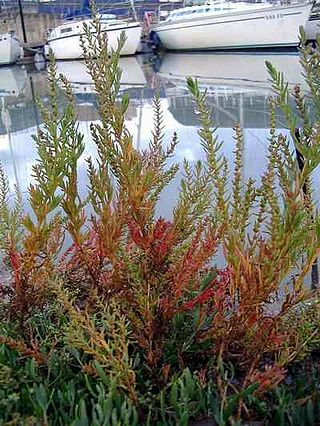
Suaeda is a genus of plants also known as seepweeds and sea-blites. Most species are confined to saline or alkaline soil habitats, such as coastal salt-flats and tidal wetlands. Many species have thick, succulent leaves, a characteristic seen in various plant genera that thrive in salty habitats.
Carl David Bouché was a German botanist and gardener. He served as Inspector of the Royal Botanic Garden in Berlin from 1843 to 1881.
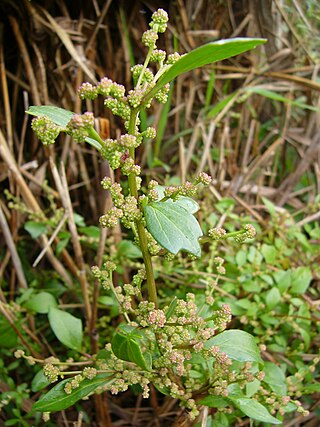
Oxybasis chenopodioides, is a species of flowering plant in the family Amaranthaceae known by the common name low goosefoot.

The Betoideae are a small subfamily of the flowering plant amaranth family, Amaranthaceae sensu lato. Commonly known members include beet, sugar beet, chard, and mangelwurzel, which all are cultivars of Beta vulgaris.

The Suaedoideae are a subfamily of plants in the family Amaranthaceae.
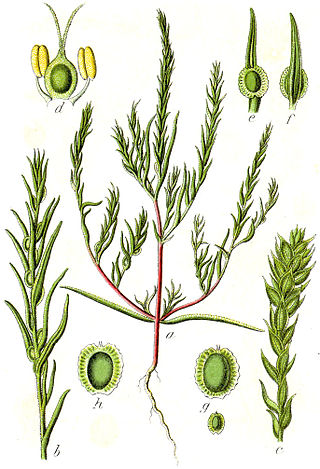
The Corispermoideae are a subfamily of the Amaranthaceae, formerly in family Chenopodiaceae.

Suaeda vera, also known as shrubby sea-blite, shrubby seablight or in the USA sometimes as alkali seepweed, is a species of flowering plant in the family Amaranthaceae. It is a small shrub, with very variable appearance over its wide range. It is a halophyte, and occurs in arid and semi-arid saltflats, salt marshes and similar habitats.

Verbena incompta, the purpletop vervain, is a species of plant from the genus Verbena. The species was described in 1995 by P.W. Michael.

Suaeda aegyptiaca is a species of succulent plant in the family Amaranthaceae, and salt-tolerant (halophyte) plant that is distributed in eastern North Africa, the Near East and West Asia.
Atriplex valdesii is a plant species endemic to Mexico. It is known from the States of Zacatecas and San Luis Potosí. It grows is saline soils in desert areas and sometimes in disturbed habitats.
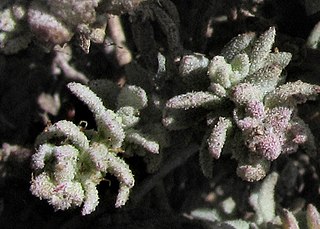
Atripliceae are a tribe of the subfamily Chenopodioideae belonging to the plant family Amaranthaceae. Atriplex is the largest genus of the tribe. Species of Atripiceae are ecologically important in steppe and semi-desert climates.
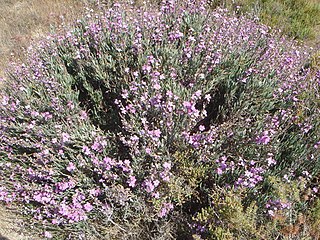
Limoniastrum is a genus of plants in the family Plumbaginaceae, containing two known species of subshrubs found the Mediterranean region, within Africa and southern Europe.

Patellifolia is a genus of flowering plants in the subfamily Betoideae of the family Amaranthaceae. These are mostly procumbent herbs occurring in the Western Mediterranean region and Macaronesia, with some isolated occurrences in North Africa and at the Horn of Africa. They are interesting as crop wild relatives of sugar beet.
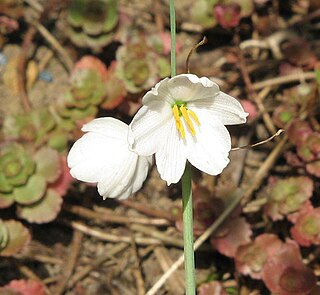
Acis valentina is a species of bulbous flowering plant in the family Amaryllidaceae, native to eastern Spain. Its white flowers appear in autumn. It can be grown as an ornamental bulb, but may need protection from hard frost.
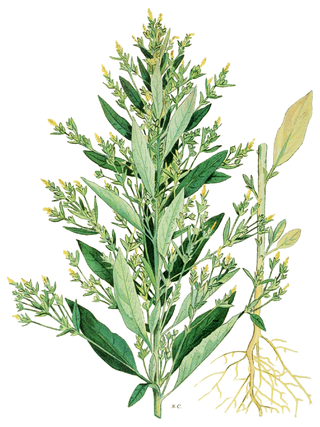
Axyris, the Russian pigweeds, are a genus of flowering plants in the amaranth family Amaranthaceae, native to temperate parts of Eastern Europe and Asia. The center of genetic diversity is the Altai to northern Tien-Shan mountains. The best known species is Axyris amaranthoides, which has become a widespread invasive in northern North America.

Herbstia is a monotypic genus of flowering plants belonging to the family Amaranthaceae. It only contains one species, Herbstia brasiliana(Moq.) Sohmer It is within the Amaranthoideae subfamily.

















